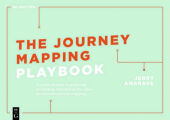 Neuerscheinungen 2020Stand: 2020-02-01 |
Schnellsuche
ISBN/Stichwort/Autor
|
Herderstraße 10
10625 Berlin
Tel.: 030 315 714 16
Fax 030 315 714 14
info@buchspektrum.de |

Jerry Angrave
The Journey Mapping Experience
A practical guide to preparing, facilitating and sharing the value of customer journey mapping
2020. 208 S. 40 col. ill., 20 col. tbl., 20 col. img. 240 mm
Verlag/Jahr: DE GRUYTER 2020
ISBN: 3-11-064111-9 (3110641119)
Neue ISBN: 978-3-11-064111-0 (9783110641110)
Preis und Lieferzeit: Bitte klicken
34 percent of all companies currently engage in the process, popular companies like Starbucks and Uber depend on customer journey maps to convey the importance of their customerīs experience at all levels of transactions to the entire company - cmnty.com
If, as a business, we are to benefit commercially from being more customer-centric then it goes without saying that we need to understand our customers better. We need to empathise with how we fit into their lives, not how we want them to fit into our processes.
Thatīs what journey mapping is all about; documenting and acting on what itīs really like to be a customer. Itīs a simple and effective tool used by organisations throughout the world and across every sector. Done effectively and strategically, its influence can be significant. Itīs a tangible, very relevant way to capture what customers are doing, thinking and feeling as they interact with us. And by overlaying what else we know from our operational metrics and existing feedback and then by validating it all with customers, we create compelling reasons to change what can be improved and celebrate whatīs already great.
34 percent of all companies currently engage in the process, popular companies like Starbucks and Uber depend on customer journey maps to convey the importance of their customerīs experience at all levels of transactions to the entire company - cmnty.com
If, as a business, we are to benefit commercially from being more customer-centric then it goes without saying that we need to understand our customers better. We need to empathise with how we fit into their lives, not how we want them to fit into our processes.
Thatīs what journey mapping is all about; documenting and acting on what itīs really like to be a customer. Itīs a simple and effective tool used by organisations throughout the world and across every sector. Done effectively and strategically, its influence can be significant. Itīs a tangible, very relevant way to capture what customers are doing, thinking and feeling as they interact with us. And by overlaying what else we know from our operational metrics and existing feedback and then by validating it all with customers, we create compelling reasons to change what can be improved and celebrate whatīs already great.
A journey mapping workshop is just the start. It can be a fantastic catalyst for driving a customer centric culture. It involves people across all functions who can then act as your customer champions wherever they work. It means business decisions are made in full knowledge of the direct and indirect impact on customers. We can prioritise changes to be the ones that will help us demonstrate our brand promise most clearly and deliver on our purpose. And we can measure how well we do whatīs most important to our customers, not just carry out a mechanical audit of our processes.
Journey mapping is a hugely versatile tool that will benefit any organisation of any size and complexity. It can be used to establish the starting point; a common understanding of what todayīs experience is really like. Beyond that we can use the frameworks to design future-state and innovative experiences, we can map the journeys of other customers personas and employees.
So if we get it right and make the right, empathetic changes, customers will buy from us again, theyīll be prepared to pay more, buy more and theyīll tell everyone to do the same. We can communicate with them in their language and in a way thatīs more relevant and timely. And those involved will learn more about their own business; they will establish informal and formal cross functional working relationships. It stimulates excitement and stories within the business where everyone wants to get involved and support the drive for greater customer centricity. What then follows is simple: better experiences mean be
Jerry Angrave, Empathyce, Cheltenham, UK


